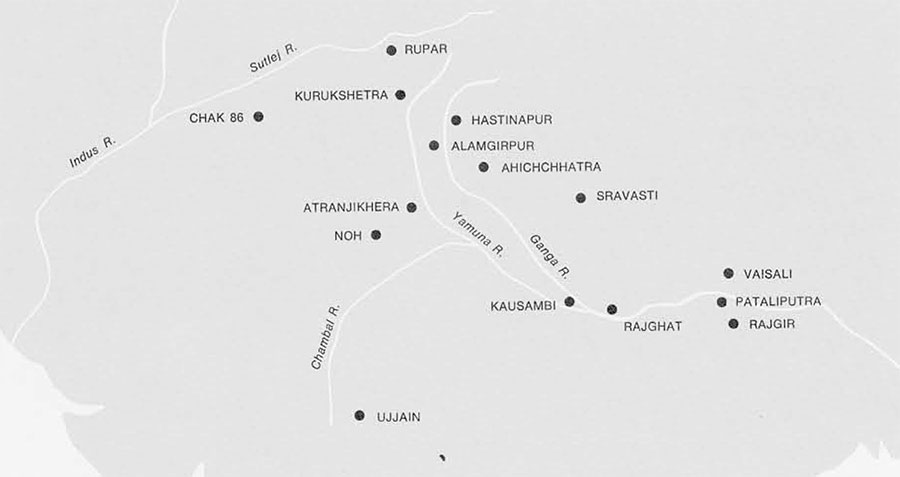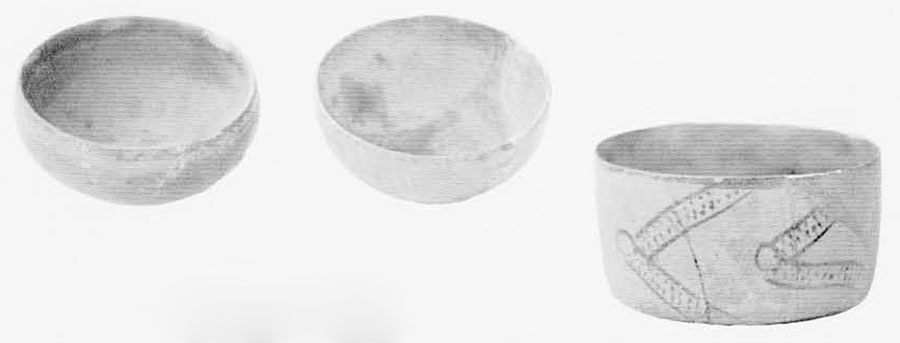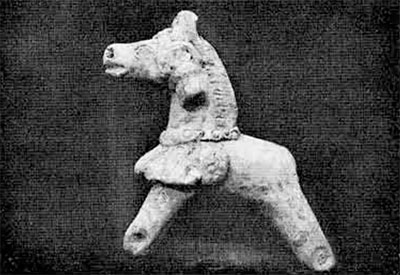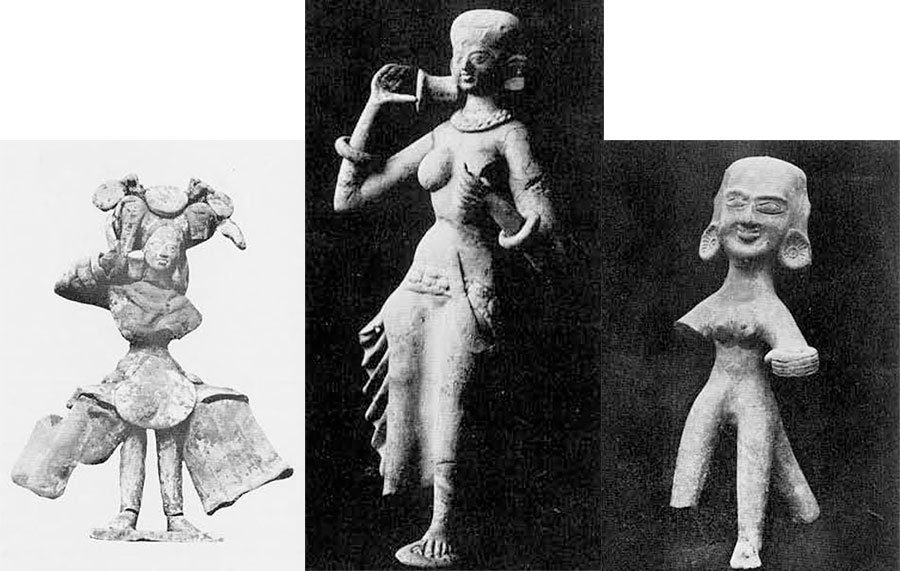
Due to the persistent efforts of archaeologists in India one of the most exciting developments which is taking place in the archaeology of South Asia is the gradual unfolding of the cultural patterns of the Ganga-Yamuna basin. A decade or two ago practically nothing was known about the material remains of the cultures which flourished in this region in the pre-Mayan times (fourth and third centuries B.C.) and all inferences had to be drawn from the Vedic literature of the Indo-Aryans and from Buddhist works. Our evidence is still meager because the potential of this region for archaeological work was realized not too long ago. But the rapidity with which new evidence is forthcoming makes assessments and reassessments a continuous process. One major task which faces us continuously is to collect and synthesize the bits and pieces of evidence made available from published and unpublished sources and assess the growth f society before the dawn of history as known from inscriptional sources.

The rapid and drastic changes in the courses of the rivers in an extensive alluvial plain make it still more difficult for us to form a picture of the settlement patterns. The settlements were in close proximity to the rivers, and any changes in the river system brought about flooding and total destruction of several small settlements, or dislocation from a close source of water supply and perhaps even loss of strategic and commercial advantages. All these factors must have necessitated frequent abandonment of sites over the centuries. Studies made by experts of the rivers of the Ganga system, for a period of the last two centuries, have shown that rivers have sometimes moved as far as 40 miles from their earlier course. The same must have been true in antiquity and must have been a major reason for the abandonment of a settlement. However, with all these limitations, we still have remains of a civilization which made its appearance in this region in the beginning of the first millennium B.C. and developed into an urban complex in the subsequent periods.
The first phase of this civilization, covering a time period of about 1,000/800 to 500 B.C. and named the painted gray ware period after its most outstanding ceramic form, has a concentration of sites in the cis-Sutlej areas of the Punjab and Rajasthan and farther east in western Uttar Pradesh; the most important southern site being Kausambi on the river Yamuna. Contact with Ujjain in Madhya Pradesh can also be indicated. The extension of this civilization in the trans-Sutlej area is not yet investigated but is highly probably and may even point to the direction from which this culture found its way into the Ganga-Yamuna basin. Thus, future research in that region should throw further light on the distribution as well as on the antecedents of this civilization and perhaps would eventually help to reconstruct an internal chronological sequence also. If the movement, for instance, was from the west to the east, then the settlements in the Punjab and Rajasthan would claim a priority over those in the Ganga-Yamuna basin proper.
Many of the western settlements of this phase are on the same sites or close to those of the earlier Harappan or Indus Valley civilization, although the two are separated from each other by centuries and there could have been no contact between them. The choice of those particular settlement sites, thus, must either have been motivated by the presence of mounds of earlier settlements or simply by the attraction to the same areas in the fertile plains of the river basins.
Generally speaking, the settlements of this civilization are along the rivers and are relatively small, that is, the city complex known from subsequent times had not yet developed. Our study, however, is based on limited surveys and excavations and it is still not possible to determine the exact extent of a settlement. At Hastinapur, the type site for this period (excavated by B.B. Lal of the Archaeological Survey of India), the mound stretches for about half a mile along the old bed of the river and is about a quarter mile wide. Excavations have proved that the whole mound was not occupied in the early periods; on the other hand, there is evidence indicating that a considerable part of the settlement must have been washed away by the floods which mark the close of the painted gray ware period. At Ahichchhatra the wall enclosing the later settlement has a perimeter of 3 1/2 miles, but not all areas where trenches were dug revealed evidence of the early painted gray ware settlement. Neither can the precise layout of the town, nor plans of houses yet be determined. At Hastinapur and Alamgirpur there is evidence of mud and mud brick walls plastered with thick layers of clay. Thus, we may infer that the physical appearance of an average house was probably not too far removed from that of a present-day village house in the same area.
Domestication of of cattle and horses and cultivation of rice are known from Hastinapur. Glass beads and bangles, bone objects, crude terracotta animal figures, copper and iron tools and weapons are some of the other items associated with this culture. In this phase is the earliest known occurrence of iron objects in India and from all the evidence available as of today it appears that the working if the metal was known to the people when they first settled in this region. Iron objects in large numbers are reported from the earliest levels of the painted gray ware period at Atranjikhera, a site in the Etah district of Uttar Pradesh currently under excavation by the Aligarh University. According to the excavators, numerous “circular fire pits,” in certain cases with openings on one side, were also found and may have served as furnaces for iron working. A similar “furnace” is reported from Ujjain from a later period.
Sometime in the middle of the first millennium B.C. and before the end of the painted gray ware phase, developments took place which show a more advanced technology and perhaps the beginning of urban life. These matured and spread during the following phase, covering a period of about 500-200 B.C., and are characterized by a typical ceramic industry popularly, although inaccurately, known as the northern black polished ware. Whatever may have been the contributing factors–whether indigenous in the Ganga-Yamuna basin on the one hand and around Ujjain on the other, or extraneous from Iran and farther west, or both–this phase shows greater skill and affluence.
The area in which there is a concentration of settlements are the plains watered by the rivers of the Ganga system, Ujjain farther south, and extensions in the Punjab and Rajasthan. The choice of sites for settlements continued to be along the rivers and in many instances remained the same as before. But the actual area of a settlement became more extensive, indicating a larger concentration of population at these sites. Along with the increase in area is the appearance of the first walled cities of the Ganga-Yamuna basin. The construction of ramparts and moats around major cities became a more or less normal feature and must have served as a defense against both flood waters and warfare. The need and the resources for taking such, in certain cases rather elaborate, defensive measures indicate more affluence and also more intricately involved relationships of a political order. However, the settlement was not confined to the walled city only. At least at Kausambi and Ujjain, for which archaeological evidence is available, the peripheral regions were also inhabited. At the site of Ujjain, situated on the river Sipra, the rampart enclosed an irregular area with a major axis of about a mile and a maximum width of about three-quarters of a mile. The rampart was partly circumscribed by the river and partly by a moat made by diverting its waters on the remaining sides. The moat was about 150 feet wide and about 20 feet deep, while the rampart, made of dug-up clay, with a basal width of about 250 feet and a height of about 40 feet, was reinforced on the outside of timber breakwaters set diagonally to the stream. There is evidence of the fortifications having been breached several times and repaired and reinforced by brick revetments built on a raised level of the rampart.
At Kausambi, situated on the river Yamuna (excavated by G.R. Sharma), the entire settlement is said to have covered an area of about eight square miles, but the walled city had a circuit of about four miles. The rampart, standing to a height of 40 feet intersected by towers and gateways, reveals a history of additions and enlargements spread over a period of several centuries. The ramparts of Ahichchhatra, Vaisali, Sravasti, Rajgriha and Rajghat all date from the same general period. The rampart of Ahichchhatra has a circuit of about three and a half miles. The stone defenses of Rajgriha when complete must have been some 25 miles in length, and are unlike any others in being dry built of large unshaped stones intersected by square shaped bastions also built in a similar fashion. This simple method of construction, as opposed to the other examples discussed above, should be attributed to the location of the site itself. The valley of Rajgriha is surrounded by hills and the fortifications run along them. Stone was the most easily accessibly material in the area and the problem of defense against river waters was not the concern of the builders in this case.
Better known, but later in date, is the complex at Pataliputra which is considered to be of the Mauryan times. Megasthenes’ description of the famour Mauryan capital city and its defenses is well known. The wooden ramparts and the massive teakwood platforms at Bulandibagh, and the ruins of the Asokan Hall at Kumrahar in Patna bear on the testimony of Megasthenes.

Defenses, although the most outstanding, are certainly not the only known structural features of the cities of this period. Both Ujjain and Kausambi have yielded buildings of different types and different construction materials. At Kausambi the most interesting are the palace and the monastery complexes. The palace complex, earlier in date than the monastery, covers an extensive area and represents several stages of building activity. A detailed report on its plan would certainly be a valuable addition to our knowledge of this period. The Buddhist monastery also has several building levels and the finding of an inscription identifies it with the Ghoshitarama establishment mentioned in Buddhist literature. This phase, accordingly, marks the first definitely identifiable religious structures. An easy supply of water to the walled city must have been of considerable importance, for at Ujjain excavations revealed a water tank measuring 34 feet by 26 feet. At Rupar also was excavated the retaining wall of a tank with a brick built inlet. Typical of this period are soakage pits made of superimposed terracotta jars with perforated bases. Building materials comprised burnt brick, mud brick, and stone for different types of construction.
It is still too early to evaluate precisely the development in industries and specialized skills associated with individual cities, nor is it possible to assess how much interaction there was between different settlement centers. Buddhist literature speaks of prosperous cities, flourishing commerce and trade. Archaeological data still consist of bits and pieces but perhaps future work will throw further light on the picture. At Ujjain there is evidence for two local industries. A tile-roofed mud house proved to be a workshop for the manufacture of beads of agate and arrowheads and needles of bone. Several unfinished samples along with raw material and iron tools are said to have been associated with it. Manufacture of beads is reported from Rupar also. At Ujjain enormous deposits of iron slag and the discovery of an open hearth, according to the excavator, N.R. Banerjee, show signs of an iron-working industry.
In pottery especially there is a tendency towards excellence. Of all the ceramic forms the most outstanding and widespread is the so-called northern black polished water. The ware is wheel-made, extremely fine, and with a highly lustrous surface. The surface color ranges from a gray, brown, black to a silvery metallic quality. No satisfactory chemical analysis of the composition and finish of this pottery has yet been done. This ceramic ware seems to have evolved in the Ganga-Yamuna basin and covers approximately a time period between about 500 and 200 B.C. with perhaps a later survival in the peripheral regions. The pottery itself seems to be the product of a steady development and is not of sudden emergence. At several sites like Sravasti, Alamgirpur, and Ahichchhatra, a transitional stage between the painted gray ware and northern black polished ware can be observed; and an early stage in its development, leading to the highly lustrous variety, seems to be the plain black-slipped ware. At Rajghat the plain black-slipped ware was found in levels earlier than those in which the mature form of northern black polished ware occurs.

One important shift in emphasis seems to be indicated by the nature of terracotta figurines. Terracottas associated with the pre-northern black polished ware are relatively few, cruder, and generally represent animal figures. While the terracottas of the northern black polished ware phase show a larger variety , especially outstanding are the numerous female figurines of many types. Museums in India are flooded with such figurines. The finding of some now in stratified excavations enables us to put them in a cultural context. Some of the figurines were most probably related to religious rites as is common in India even today. Their appearance from approximately the middle of the first millennium B.C. with no apparent influx of new related ideas from outside, as indicative of changing values pertaining to religious ritual.

Other new developments can be seen in the first appearance of writing, the introduction of currency, and so forth. The inscriptions of Asoka (3rd century B.C.) are the earliest form of writing which has come down to us (other than in the Indus Valley), but the script indicates an earlier origin. Dating from the middle of the first millennium B.C. are also the earliest coins of the punchmarked and cast varieties. There is extensive use of iron and a great variety in small finds including items of luxury and daily use. Thus, the overall picture is that of technological developments and greater prosperity as compared to the earlier half of the millennium.
The middle of the first millennium B.C., in terms of historical tradition, was a period of great intellectual and spiritual ferment, the legacy of which is Buddhism and Jainism. Literature of the Buddhists and Jains also speaks of kings and chiefs, of political and commercial activities, of traders and bankers, and of cities and towns. The focus of this unrest and activity was the Ganga valley. Many of the cities mentioned in literature are known to us also from archaeological evidence. Both literature and archaeology give evidence of a civilization of the same time and in the same area. Thus, it seems that the fresh intellectual stimulation and other societal developments we have traced above were simultaneous and perhaps the results of complex interactions, making the sum total of a civilization.
